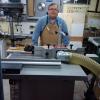I have used biscuits when I edge glue up a panel, and to my knowledge I have never had any issue.
However when I look at furniture from the REALLY high end stores I notice that all their large flat panels use a reversible glue joint. It looks kind of neat. Do they do that for strength? If so is it really necessary? Or do they do that because in high volume you can "dail in" the process and work faster.
I worry that if I tried it (I don't have a power feeder or a shaper just a hand fed router table) that I would forever fight getting things lined up perfect. Then end up having to take my panel somewhere that has a giant drum sander to fix my mistakes.
I know I could pay the $50 and try it out, but I would like to hear from the experienced folks before I considered whether to try it.




 Reply With Quote
Reply With Quote






